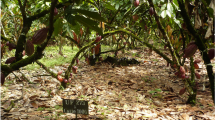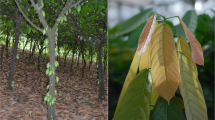Abstract
Climate is one of the main abiotic factors influencing natural selection patterns. Year-to-year variation in climate is postulated to elicit temporal shifts in the direction and form of selection. Here, we examine the importance of trait means and plasticities for fitness under interannual variation in rainfall and assess the shifts in selection in cork oak. We performed selection analyses using the progeny of 45 mother trees established in a common garden experiment across two consecutive years that differed in rainfall. Growth and seven functional traits (specific leaf area, leaf size, leaf shape traits, 13-carbon isotope discrimination, and leaf nitrogen) related to drought tolerance were measured. Selection analyses showed fitness benefits of reduced specific leaf area (SLA) in a dry year and increased leaf size in a mesic year, indicating that they are key traits for this evergreen oak to cope with different water availabilities. SLA and leaf size were also particularly plastic traits, but the adaptive significance of plasticity could not be confirmed. The absence of correlation between growth across years using family means and the absence of correlations between SLA and leaf size suggested that fluctuating selection over time favored different maternal families under different annual weather conditions, which could promote functional diversity within populations in this long-lived species.



Similar content being viewed by others
References
Alía R, García del Barrio JM, Iglesias S, Mancha JA, de Miguel J, Nicolás JL, Pérez F, Sánchez de Ron, D (2009) Regiones de procedencia de especies forestales en España. Ministerio de Medio Ambiente y Medio Rural y Marino. 363 pp. Madrid
Arnold SJ, Wade MJ (1984a) On the measurement of natural and sexual selection: theory. Evolution 38:709–719
Arnold SJ, Wade MJ (1984b) On the measurement of natural and sexual selection: applications. Evolution 38:720–734
Aronson J, Pereira JS, Pausas JG (2009) Cork oak woodlands on edge: ecology, adaptive management and restoration. Island, Washington, DC
Bell G (2010) Fluctuating selection: the perpetual renewal of adaptation in variable environments. Proc R Soc Lond B Biol Sci 365:87–97
Bisang I, Ehrlén J, Hedenäs L (2008) Are annual growth intervals independent units in the moss Pseudocalliergon trifarium (Amblystegiaceae). Bryologist 111:435–443
Burger R, Gimelfard A (2002) Fluctuating environments and the role of mutation in maintaining quantitative genetic variation. Genet Res 80:31–46
Caruso CM, Maherali H, Sherrard M (2006) Plasticity of physiology in Lobelia: testing for adaptation and constraint. Evolution 60:980–990
Catalan G (2003) Collection of material. In: Varela MC (ed) Handbook of the EU concerted action on cork oak, FAIR I CT 95 0202. INIA, Lisbon, pp 33–46
Donovan LA, Dudley SA, Rosenthal DM, Ludwig F (2007) Phenotypic selection on leaf water use efficiency and related ecophysiological traits for natural populations of desert sunflowers. Oecologia 152:13–25
Donovan LA, Ludwig F, Rosenthal DM, Rieseberg LH, Dudley SA (2009) Phenotypic selection on leaf ecophysiological traits in Helianthus. New Phytol 183:868–879
Dudley SA (1996) Differing selection on plant physiological traits in response to environmental water availability: a test of adaptive hypotheses. Evolution 50:92–102
Etterson JR (2004) Evolutionary potential of Chamaecrista fasciculata in relation to climate change. I Clinal patterns of selection along an environmental gradient in the Great Plains. Evolution 58:1446–1456
Fairbairn DJ, Preziosi RF (1996) Sexual selection and the evolution of sexual size dimorphism in the water strider, Aquarius remigis. Evolution 50:1549–1559
Fusco G, Minelli A (2010) Phenotypic plasticity in development and evolution: facts and concepts. Philos Trans R Soc B Biol Sci 365:547–556
Gandour M, Khouja ML, Toumi L, Triki S (2007) Morphological evaluation of cork oak (Quercus suber L.): Mediterranean provenance variability in Tunisia. Ann For Sci 64:549–555
Gimenez-Benavides L, Garcia-Camacho R, Maria Iriondo J, Escudero A (2011) Selection on flowering time in Mediterranean high-mountain plants under global warming. Evol Ecol 25:777–794
Grant PR, Grant BR (2002) Unpredictable evolution in a 30-year study of Darwin’s finches. Science 296:707–711
Greenberg CH (2000) Individual variation in acorn production by five species of southern Appalachian oaks. For Ecol Manag 132:199–210
Grossmann A, Romane F, Grandjanny M (2002) The climate environment of the ‘CASCADE’ sites. II Report CNRS-CEFE for the EU Project EVK2-CT-1999-00006
Guyette RP, Muzika R, Kabrick J, Stambaugh MC. 2004 A perspective on Quercus life history characteristics and forest disturbance. In: Spetich M (ed) Proceedings of the upland oak ecology symposium. Gen. Tech. Rep. SRS-73. US Department of Agriculture, Forest Service, Southern Research Station, Asheville, 311 pp
Heschel MS, Riginos C (2005) Mechanisms of selection for drought stress tolerance and avoidance in Impatiens capensis. Am J Bot 92:37–44
Hunt J, Breuker CJ, Sadowski JA, Moore AJ (2009) Male-male competition, female mate choice and their interaction: determining total sexual selection. J Evol Biol 22:13–26
Jump AS, Hunt JM, Martinez-Izquierdo JA, Penuelas J (2006) Natural selection and climate change: temperature-linked spatial and temporal trends in gene frequency in Fagus sylvatica. Mol Ecol 15:3469–3480
Kingsolver J, Diamond S, Siepelski A, Carlson S (2012) Synthetic analyses of phenotypic selection in natural populations: lessons, limitations and future directions. Evol Ecol 26:1101–1118
Kingsolver JG, Diamond SE (2011) Phenotypic selection in natural populations: what limits directional selection? Am Nat 177:346–357
Kruuk LEB, Merilä J, Sheldon BC (2003) When environmental covariance short-circuits natural selection. Trends Ecol Evol 18:207–208
Lande R, Arnold SJ (1983) The measurement of selection on correlated characters. Evolution 37:1210–1226
Littell RC, Henry PR, Ammerman CB (1998) Statistical analysis of repeated measures data using SAS procedures. J Anim Sci 76:1216–1231
Matesanz S, Valladares F (2014) Ecological and evolutionary responses of Mediterranean plants to global change. Environ Exp Bot 103:53–67
Mauricio R, Mojonnier LE (1997) Reducing bias in the measurement of selection. Trends Ecol Evol 12:433–436
Milla R, Escudero A, Iriondo JM (2009) Inherited variability in multiple traits determines fitness in populations of an annual legume from contrasting latitudinal origins. Ann Bot 103:1279–1289
Morrissey MB, Hadfield JD (2012) Directional selection in temporally replicated studies is remarkably consistent. Evolution 66:435–442
Nicotra AB, Cosgrove MJ, Cowling A, Schlichting CD, Jones CS (2008) Leaf shape linked to photosynthetic rates and temperature optima in South African Pelargonium species. Oecologia 154:625–635
Nicotra AB, Davidson A (2010) Adaptive phenotypic plasticity and plant water use. Funct Plant Biol 37:117–127
Poorter H, Niinemets U, Poorter L, Wright IJ, Villar R (2009) Causes and consequences of variation in leaf mass per area (LMA): a meta-analysis. New Phytol 182:565–588
Ramirez-Valiente JA, Sánchez-Gómez D, Aranda I, Valladares F (2010) Phenotypic plasticity and local adaptation in leaf ecophysiological traits of 13 contrasting cork oak populations under different water availabilities. Tree Physiol 30:618–627
Ramirez-Valiente JA, Alia R, Aranda I (2014a) Geographical variation in growth form traits in Quercus suber and its relation to population evolutionary history. Evol Ecol 28:55–68
Ramirez-Valiente JA, Lorenzo Z, Soto A, Valladares F, Gil L, Aranda I (2009a) Elucidating the role of genetic drift and natural selection in cork oak differentiation regarding drought tolerance. Mol Ecol 18:3803–3815
Ramirez-Valiente JA, Valladares F, Gil L, Aranda I (2009b) Population differences in juvenile survival under increasing drought are mediated by seed size in cork oak (Quercus suber L.). For Ecol Manag 257:1676–1683
Ramirez-Valiente JA, Valladares F, Huertas AD, Granados S, Aranda I (2011) Factors affecting cork oak growth under dry conditions: local adaptation and contrasting additive genetic variance within populations. Tree Genet Genomics 7:285–295
Ramirez-Valiente JA, Valladares F, Huertas AD, Granados S, Aranda I (2014b) Exploring the impact of neutral evolution on intrapopulation genetic differentiation in functional traits in a long-lived plant. Tree Genet Genomics 10:1181–1190
Ramirez-Valiente JA, Valladares F, Sanchez-Gomez D, Huertas AD, Aranda I (2014c) Population variation and natural selection on leaf traits in cork oak throughout its distribution range. Acta Oecol 58:49–56
Rausher MD (1992) The measurement of selection on quantitative traits – biases due to environmental covariances between traits and fitness. Evolution 46:616–626
Reed TE, Waples RS, Schindler DE, Hard JJ, Kinnison MT (2010) Phenotypic plasticity and population viability: the importance of environmental predictability. Proc R Soc Lond B Biol Sci 277:3391–3400
Reich PB, Ellsworth DS, Walters MB, Vose JM, Gresham C, Volin JC, Bowman WD (1999) Generality of leaf trait relationships: a test across six biomes. Ecology 80:1955–1969
Saldana A, Lusk CH, Gonzáles WL, Gianoli E (2007) Natural selection on ecophysiological traits of a fern species in a temperate rainforest. Evol Ecol 21:651–662
Scheiner SM, Mitchell RJ, Callahan HS (2000) Using path analysis to measure natural selection. J Evol Biol 13:423–433
Schluter D, Price TD, Rowe L (1991) Conflicting selection pressures and life history trade-offs. Proc R Soc Lond B Biol Sci 246:11–17
Shaw RG, Geyer CJ (2010) Inferring fitness landscapes. Evolution 64:2510–2520
Shefferson RP, Roach DA (2010) Longitudinal analysis of Plantago: adaptive benefits of iteroparity in a short-lived, herbaceous perennial. Ecology 91:441–447
Sherrard ME, Maherali H (2006) The adaptive significance of drought escape in Avena barbata, an annual grass. Evolution 60:2478–2489
Siepielski AM, DiBattista JD, Carlson SM (2009) It’s about time: the temporal dynamics of phenotypic selection in the wild. Ecol Lett 12:1261–1276
Siepielski AM, DiBattista JD, Evans JA, Carlson SM (2011) Differences in the temporal dynamics of phenotypic selection among fitness components in the wild. Proc R Soc Lond B Biol Sci 278:1572–1580
Soto A, Lorenzo Z, Gil L (2007) Differences in fine-scale genetic structure and dispersal in Quercus ilex L. and Q. suber L.: consequences for regeneration of Mediterranean open woods. Heredity 99:601–607
Stanturf JA, Stone EL, McKittrick RC (1989) Effects of added nitrogen on growth of hardwood trees in southern New York. Can J For Res 19:279–284
Stinchcombe JR, Rutter MT, Burdick DS, Tiffin P, Rausher MD, Mauricio R (2002) Testing for environmentally induced bias in phenotypic estimates of natural selection: theory and practice. Am Nat 160:511–523
Umina PA, Weeks AR, Kearney MR, McKechnie SW, Hoffmann AA (2005) A rapid shift in a classic clinal pattern in Drosophila reflecting climate change. Science 308:691–693
Valladares F, Balaguer L, Martinez-Ferri E, Perez-Corona E, Manrique E (2002) Plasticity, instability and canalization: is the phenotypic variation in seedlings of sclerophyll oaks consistent with the environmental unpredictability of Mediterranean ecosystems? New Phytol 156:457–467
Valladares F, Martinez-Ferri E, Balaguer L, Perez-Corona E, Manrique E (2000) Low leaf‐level response to light and nutrients in Mediterranean evergreen oaks: a conservative resource‐use strategy? New Phytol 148:79–91
Valladares F, Sanchez D, Zavala MA (2006) Quantitative estimation of phenotypic plasticity: bridging the gap between the evolutionary concept and its ecological applications. J Ecol 94:1103–1116
van Tienderen PH (1991) Evolution of generalists and specialists in spatially heterogeneous environments. Evolution 45:1317–1331
Wade MJ, Kalisz S (1990) The causes of natural selection. Evolution 44:1947–1955
Acknowledgments
We are grateful to Pedro Fernández, Laura Castro, Regina Chambel, José María Climent, Pilar Jiménez, and everyone from the Forestry School of Madrid who collaborated in the setting up of the cork oak common gardens under the EU-concerted action on cork oak, FAIR I CT 95 0202. We would like to thank Salustiano Iglesias and the DGB for the maintenance of the assays. We thank Santiago de Blas, José Antonio Mancha, and other field assistants for their help during the experiment. We are also grateful to Nick Deacon for the English revision and comments of the final version of the manuscript. This work was funded by the Spanish Ministry of Science (PLASTOFOR, AGL-00536/FOR, and REMEDINAL). This study was also supported by the postdoctoral Gonzalez Esparcia scholarship to JARV.
Data archiving statement
Phenotypic data will be archived in the DRYAD. JARV has already registered, and the dataset will be submitted using his personal account in case the manuscript is considered for publication.
Author information
Authors and Affiliations
Corresponding author
Additional information
Communicated by A. Kremer
This article is part of the Topical Collection on Adaptation
Electronic supplementary material
Below is the link to the electronic supplementary material.
Supplementary Table S1
(DOC 39 kb)
Supplementary Table S2
(DOC 37 kb)
Supplementary Fig. S1
(DOC 47 kb)
Supplementary Fig. S2
(DOC 76 kb)
Rights and permissions
About this article
Cite this article
Ramírez-Valiente, J.A., Valladares, F., Delgado, A. et al. Understanding the importance of intrapopulation functional variability and phenotypic plasticity in Quercus suber . Tree Genetics & Genomes 11, 35 (2015). https://doi.org/10.1007/s11295-015-0856-z
Received:
Revised:
Accepted:
Published:
DOI: https://doi.org/10.1007/s11295-015-0856-z




